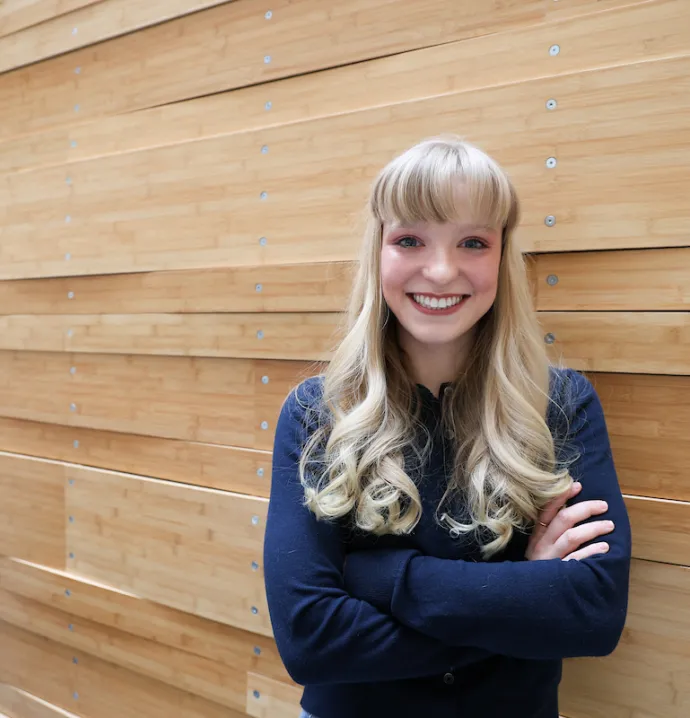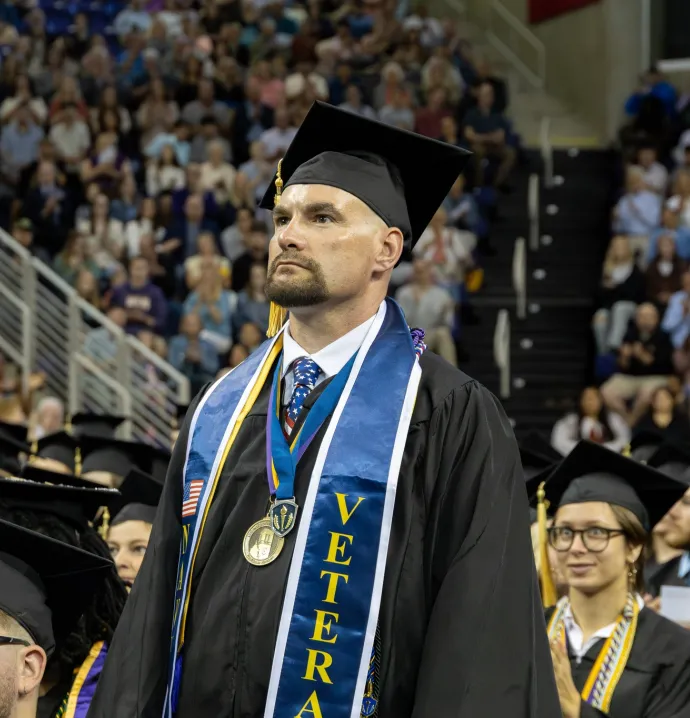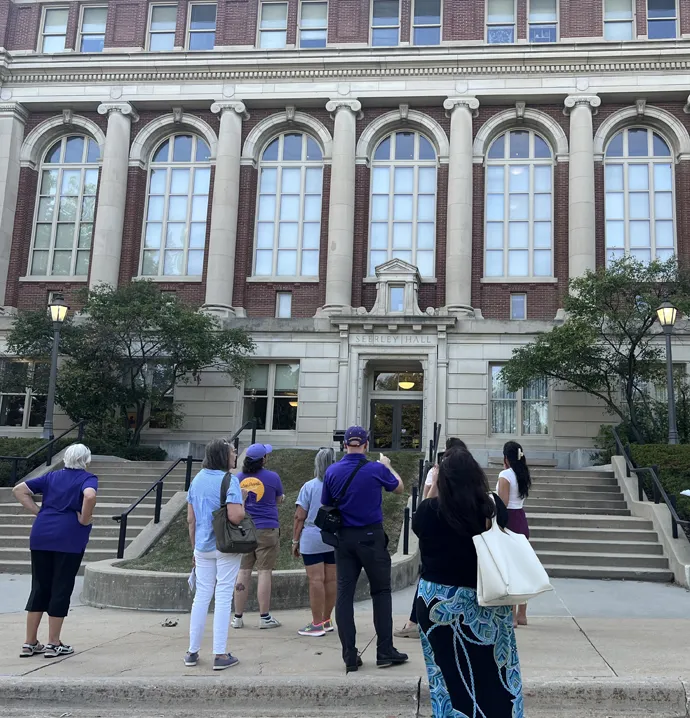5 Questions with UNI alum David Schmitz
5 Questions with UNI alum David Schmitz
David Schmitz ‘06 is proof that art can change lives. The Charles City native said his time at UNI was transformative - from creating his own unique artwork to his first exposure promoting the arts while a UNI Gallery of Art student worker. Those experiences sparked a passion for promoting art and a career that led from the Dubuque Museum of Art to the Iowa Arts Council, where he will start as administrator late next month promoting the arts across Iowa. Here he shares his thoughts on the importance of art, how to make it more accessible and how UNI shaped his career.
When did you first develop an appreciation for art? How did your UNI education in studio art prepare you for your work in this area?
I was the kid who, from before the age of 10, had a paintbrush and a pencil in his hand. If there was a youth art contest, I wanted to be in it. I had a very early love affair with the visual arts; art just appealed to me and came naturally to me from a young age. I was lucky to have good parents, teachers and mentors who said fine art can be a viable career path and encouraged me, because that’s really key.
Arts administration was not a term I heard a lot at UNI, partially because I was just very focused on making my artwork. But a mentor at UNI, Darrell Taylor, director of the UNI Gallery of Art, took me under his wing. I worked for Darrell the summer before my senior year and then through my senior year of college. It really opened up this world that is arts administration. What arts administration means to me is being a bridge between artists and communities. It’s working with artists to support them and enable their artistic vision, and then to connect it with communities, whether that be an academic university environment, like UNI, or like I do here in Dubuque with a general population.
I think what makes UNI really special is its commitment to teaching. Obviously, it started as a teaching college, preparing K through 12 teachers, and I think that really permeates the culture. All of my instructors were so attentive to my development—not just my major professors. That's what I think is really unique. It's maybe partly a function of UNI’s size, but I also think it's a function of that commitment to teaching. Looking back, that’s what I really value about UNI.
One of the things you’re passionate about is art education. Why is arts education important for children and our communities?
I know that I would not have a life in the arts if there had not been an emphasis on art in my K-12 education. Apart from the fact that I'm grateful that I've been able to make a life and a career in the arts, I also feel like it imparted some skills that I use daily, and would use regardless of whether I worked in the arts — a love of reading, a love of problem solving, the ability to think critically. Those are all things that the arts, particularly, I think, the visual arts, really encourage.
My personal passion is combined with evidence that arts education is something worth fighting for. The data that's been coming out, just in the last few years, is unequivocal that for students who are exposed to art at an early age, there are so many measurable gains. Academically, students have lower dropout rates, they have higher school attendance rates, they graduate from college at higher rates. These gains are even more pronounced for students from disadvantaged backgrounds. So it's more than just wanting kids to appreciate art for its own sake. It's also really linked to how well you do later on in school.
I’m excited to work with our education specialists, both at the Iowa Arts Council and in the Department of Education, and across the state to make sure that there's really robust support for arts education, particularly in our public schools. Just within the last two years, Iowa adopted some new Fine Arts standards. So it’s a really big opportunity right now for our state to think about how the arts can be integrated across the curriculum; how we integrate it with other subjects like the STEM fields.
We're hearing people from outside of the traditional arts world saying that the arts are important to be part of STEM, because of the fact that we live in an innovation economy and a creative economy. In recent years, a lot of business leaders in particular are saying, ‘STEM is great and we need to keep a strong focus on the core skills in those fields, but unless you combine that with creativity and the ability to think in very novel and innovative ways, then we're just making people who are excellent specialists, we're not making whole learners and innovators, which is what our economy depends upon. It's a huge area of opportunity and it’s something that I'm excited to keep advocating for.
How do you define art? How does art impact society and culture at large?
I think, at different points in your life, how you define art probably changes a little bit. If you ask a five year old and you ask a 95 year old, they might have different responses. But for me, as an artist by training, I'm going to quote one of my UNI professors, Crit Streed. I remember distinctly Crit saying, “Art is whatever human beings make and call art — period.” I always kind of loved that.
As an arts administrator, and now having done that for more than 10 years, what I would add to that definition is that art is also something that communicates something that maybe can't be communicated through other ways, like language or numbers. And maybe it does it through symbolic means. Maybe it does it through emotional means. But art communicates something about our human experience. For that to happen, it means that there needs to be an artist and a viewer. And that the experience that happens between when the artist makes something and the viewer encounters it is also part of to me what makes art, art.
Seen through that lens, art should also help to better a community; it should help a community to understand itself. It should help a community to foster civic pride, remember its past and envision its future.
Making art is really that process of trying to develop your voice or your vision in a way that you’re
communicating something to others about your lived experience or your ideas about the world. Art needn’t be intimidating, but it is something a little bit more specific than just creative expression. There are people who really can commit themselves to developing their voice as a singer or their chops as a painter or a writer. And encountering that even if you don’t feel like you have those abilities shouldn’t be intimidating. In fact, it should lend to your appreciation of art, and it should make you just appreciate the talents that people have. I'm a fan of everyday creativity and I think it’s awesome just how many outlets we have now for creative expression and finding things that are artful everywhere. But I also think it's important that we nurture those people who really are dedicating themselves to creating art and trying to sustain a living doing that.
You were already involved with the Iowa Arts Council in 2013, and just started a new role, as administrator for the council. What does the Iowa Arts Council do and what does your new role look like?
What the Iowa Arts Council’s mission statement means to me is that every Iowan should have access to the arts where they live. That's what the state arts councils do, and historically have done since they were founded in the mid-1960s, as part of the Great Society movement.
While I was with the Arts Council the first time, as a community arts specialist, my job was to help local arts organizations develop a strong role for the arts, including public art, in their community. My new role will continue to entail a focus on that, as well as overseeing our grant funding, professional development and capacity building programs, and initiatives around arts education and supporting our staff who specialize in those areas.
Iowa is unique, to some extent, for having both large swaths of our state that are rural, as well as these dense population centers, so how you serve those is an interesting challenge. I think both have a lot of things to learn from each other. I think our urban and rural areas have a lot of things to learn from each other. In the urban parts of the state, we see a lot of exciting things happening around public art and murals, for example.
But I think urban areas have a lot to learn from rural Iowa as well, with the arts playing a large role in civic life. Grassroots community arts projects are popping up in communities of all sizes across our state, and sometimes with very small budgets.These projects are accomplished through the resourcefulness of community members and volunteers. In both our urban and rural areas, we see a focus on creative placemaking, which means using historic assets and the arts working in tandem with urban planning and development. This is part of what makes Iowa so unique.
If you had to convince someone who wasn’t interested in art to come to an art museum, what would you tell them?
I’d say, ‘Come to the museum and I promise to show you something that you like, and something that you don't; something that makes you feel happy, and something that makes you sad; and probably something that confuses you. And I could go on with that list. In doing so, art will connect you with all of the emotions that you have within you. And it will connect you with many different types of experiences and time periods. And the effect of that is you'll leave with a different perception of the world around you. That's what art can really do for everyone.
This interview was edited for clarity and length. Photos were provided courtesy of Julien’s Journal / © Digital Dubuque Photography.




